Today in Tedium: In some ways, when I became a graphic designer in the newspaper industry, I had it easy. By that time, wire photos were already being transmitted primarily over the internet, and those that weren’t could quickly be scanned into a digital format via a flatbed scanner. To place those images on the page, all I had to do was hit a key command, and suddenly, I was ready to paste an image in. A lot of things had to happen to get us to that point, and one of those things was a process called phototelegraphy. This concept, essentially, refers to the process of distributing images via wires or through the radio, something that we’ve covered in other ways previously, but not directly. In many ways, it cuts to the heart of why we call wire services wire services. And because I love newspapers, I’m going to tell you all about them. Today’s Tedium talks about formative efforts to spread photographs far and wide. — Ernie @ Tedium
Give the gift of research. This Black Friday, Newspapers.com is offering a $20 discount on its popular Publisher Extra plan—which should prove the perfect holiday gift for the budding newsletter author or historian in your life. Tedium swears by it, and you will, too. Check out the deal here.
1884
The year that German technologist Paul Gottlieb Nipkow filed a patent application for a Nipkow disk, a large spinning disk with holes drilled into it, attached to a light source, that can reproduce an image with scanlines, much as a cathode ray tube can. The Nipkow disk, while not a particularly elegant solution in the modern day (you need to spin the disk really fast and make the disk particularly large to get good results) nonetheless inspired many early efforts to produce phototelegraphy and television. It was a purely mechanical method that would eventually inspire less mechanical approaches. (Here’s an example, if you’re curious.) Nipkow was able to use the device to transfer images over long distances using the method.
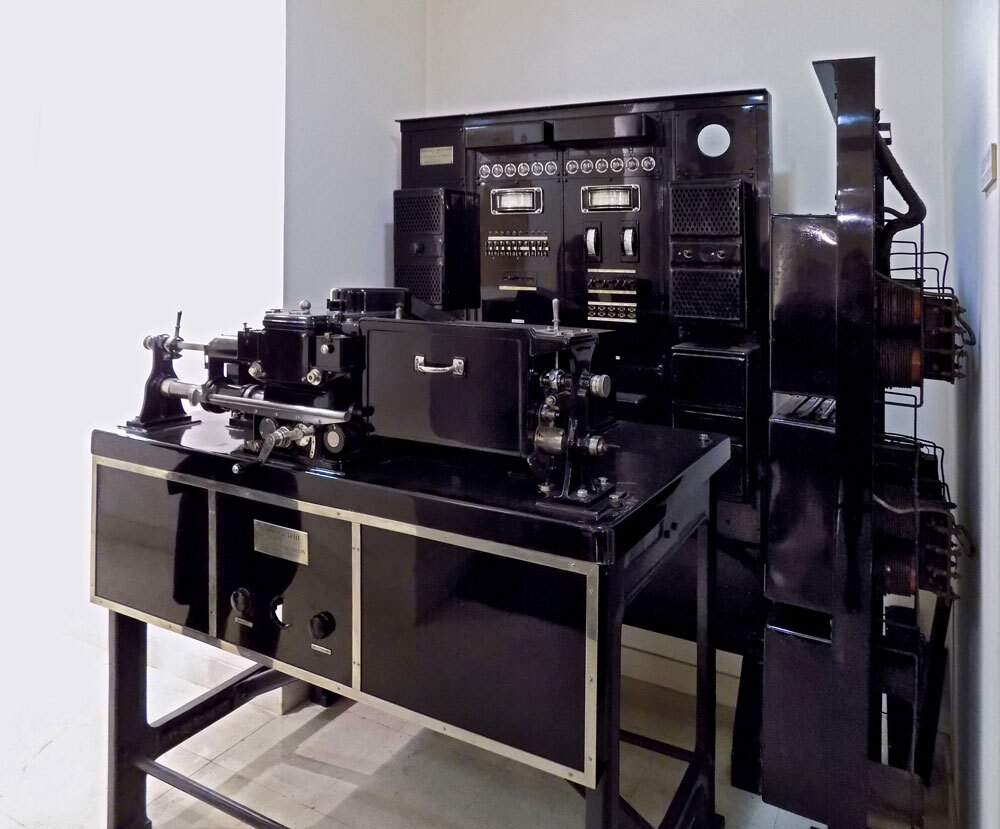
An example of a Belinograph, an early photo-distributing machine upon which the AP Wirephoto service was based. (Milica Buha/Wikimedia Commons)
The technology needed to spread photographs from one part of the world to another
You might be familiar with the way some pieces of photojournalism in prior decades became iconic—the Kent State shooting, Iwo Jima, graphic images from Vietnam, Tiananmen Square, the Challenger explosion, the Hindenburg explosion—and the way that wide exposure of those images came to ensure that those images would dominate the way that we saw the world.
The reason those images were allowed to become iconic was because of the fact that they could be distributed widely, globally, and somewhat quickly through wire services like the Associated Press and United Press International. These services have been around for decades—Wirephoto, the service offered by the AP, first came online in 1935 and has been transmitting images ever since—but you may not be exactly sure how they did that, especially before the advent of modems or even fax machines. What was the trick?
In reality, there were a number of attempts to build the basic technology to transmit images over telephone or via the radio. And these innovations gained currency because they were naturally good fits with the needs of newsgathering—report once, spread wide.
A number of innovations through the latter half of the 19th century and the early decades of the 20th helped to make it possible to distribute images globally—becoming not only important vessels for photo reproduction, but also important precursors to later technologies like television, flatbed scanners, and the fax machine. The aforementioned Nipkow disk was an important starting point, and one that quickly evolved in the direction of other reproduction technologies.
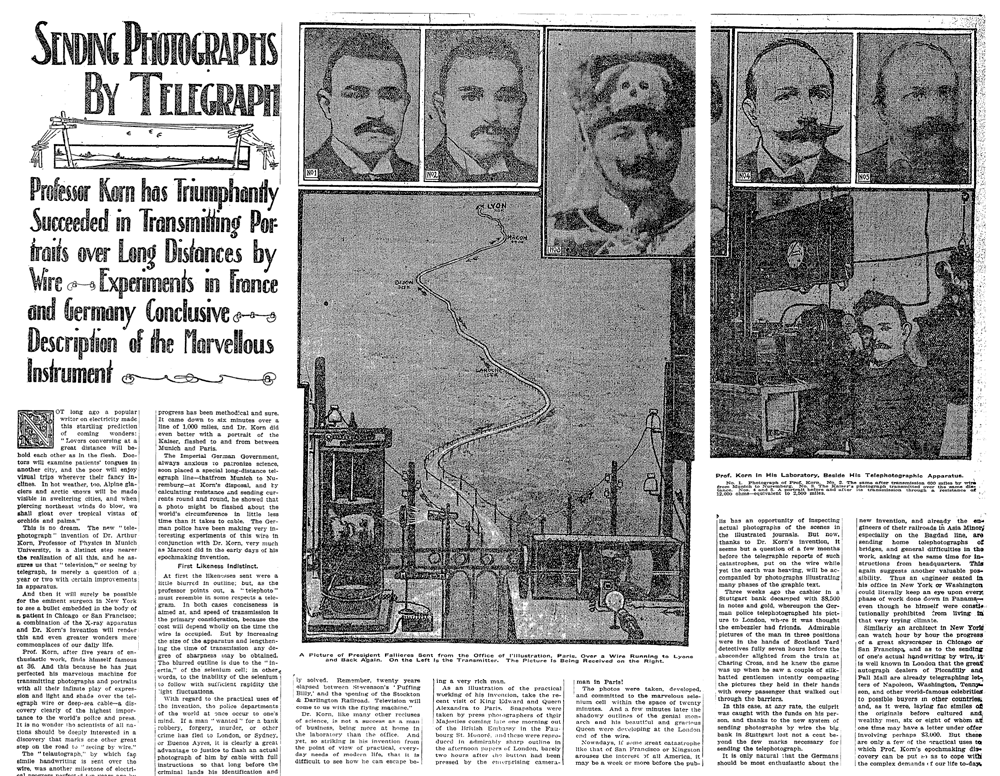
A 1907 New York Times story discussing the telautograph, a method for distributing photos through the telegraph system that is also one of the first mentions of television in the Times’ long history.
Just a few that you may find interesting:
- The kopier-telegraph. This invention, developed by Gustav Grzanna, was one of the first optical scanner technologies in use, but its primary innovation was the use of an X/Y axis to scan for information, which was then transmitted via line current over long distances. The technology also used photographic paper at the receiver end, allowing for the image to be reprinted. However, the device, despite its innovative nature, was quickly discontinued because a superior technology emerged …
- The telautograph. First developed in the late 19th century by Western Electric cofounder Elisha Gray, this technology made it possible to transmit drawings electronically. But while Gray first invented it, others quickly pushed it further By 1902, a German developer, Arthur Korn, created a variation of the device that could transmit full photographs. A 1907 New York Times article about Korn’s innovation, featuring pictures transmitted using this method, noted that Korn “assures us that ‘television,’ or seeing by telegraph, is merely a question of a year or two with certain improvements in apparatus.” This is apparently the first mention of the concept of television in the Times’ entire archive.
- The first commercial telephotography system. Herbert E. Ives, an imaging pioneer whose father was also an early imaging pioneer, developed telephotography as an employee of AT&T, with the technology being used by newspapers starting in the mid-1920s. Ives, however, was really focused on the potential of television, and immediately tried to extend his work on telephotography into some of the earliest examples of mechanical television—using, yes, Nipkow disks. Ives’ work, buoyed by the financial strength of AT&T, led to the first long-distance television transmission, a speech by then-Commerce secretary Herbert Hoover, in 1927.
When it comes to the distribution of photos over wires, however, the most pivotal invention came in 1906, when French scientist Edouard Belin developed the telegraphoscope, which used a drum to scan and then reproduce an image from a distance. A later version, which was more portable was called the Belinograph. If the word “drum” makes you think of the early cylinder-shaped wax phonographs developed by Thomas Edison, you’re not alone. As retired IEEE researcher Frederik Nebeker wrote in his 2009 book Dawn of the Electronic Age:
An early phototelegraph transmitter looked, and even functioned, something like an Edison phonograph. A photograph was mounted on a cylinder. Finely focused light illuminated one point of the photograph at a time. The cylinder rotated rapidly while the light moved slowly parallel to the axis of the cylinder, during which time a photoelectric cell registered the light reflected to it from each picture element. The phototelegraph receiver was a similar apparatus. Light-sensitive paper was mounted on the cylinder. A focused lamp, whose intensity varied with the signal strength, moved along the rotating cylinder. In order to achieve exact synchronization, which was essential, the drive motors in both transmitter and receiver were locally regulated by a tuning fork.
(If you think about it, this process is effectively the same kind of process used with a Nipkow disk—the scanning of an image electronically as it rotates—except limited to a single photograph.)
Key to making this process work was a coordination that had to occur between devices at long distances away, ensuring that the drums moved at the same rate, so the information could be accepted at the same rate as it was sent. This is not dissimilar to the “handshake” that a modem has to make at the beginning of a call. If both sides weren’t sharing the same language at the same rate, it could lead to garbled or broken information appearing.
When it worked, it really worked. Belin’s work eventually culminated in a 1921 effort to transmit a picture—an action portrait of then-president Warren G. Harding—across the Atlantic Ocean, from Annapolis, Maryland, to Paris, in a process that only took 20 minutes, which would be a lot by 2021 standards, but was basically instant by the standards of the day. It was the first picture distributed in a wireless format.
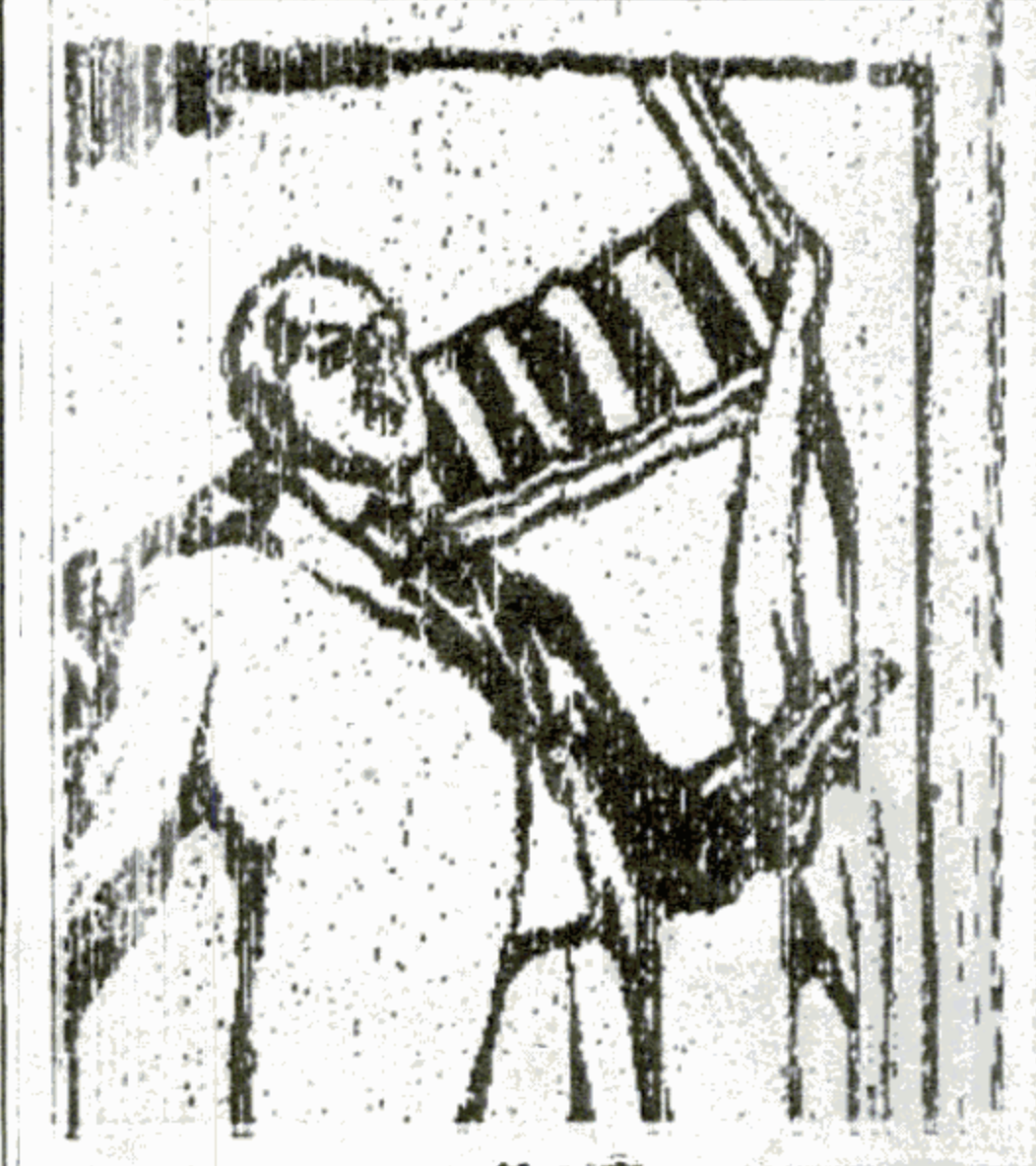
This photo of Warren G. Harding doesn’t look like much until you realize it was distributed across an ocean in 1921. (Popular Science/Google Books)
Certainly, it was not quite Instagram-quality, but as Popular Science noted, it was nonetheless extremely impressive:
Somewhat crude, but wholly recognizable, was the Harding portrait as received at the Paris end; and surely from the germ of this first wireless picture, progress to future radio broadcasting of moving news-photographs while the events pictured are actually taking place seems no more impossible than many another modern miracle that has been accomplished by science.
And it wouldn’t be the last, with later innovators like the German manufacturing conglomerate Siemens further developing the basic technology to capture even fine photographic details with its Siemens-Karolus-Telefunken picture transmission system, first put into action in 1927.
Soon enough, the technology would be good enough for some of the most important wire services in the world.
38
The number of American newspapers that initially used the AP’s Wirephoto service upon its January 1, 1935 launch. (This number is a bit mixed; a lot of modern sources say it was 39, but contemporary media at the time of its launch says 38) The service eventually grew in prominence to represent thousands of news outlets globally, and one of the first events covered by the wire service, fittingly, was that year’s Rose Bowl. (The first photo, however, was an aerial image of a plane crash.)
A video describing the distribution of spot photography dating to 1937.
How phototelegraphy helped turn the Associated Press into a global newsgathering force
The Associated Press, as you might imagine, is pretty good about reporting about its own history, which literally started with a Pony Express route paid for by a bunch of newspapers looking to get information about the Mexican-American War. That spirit of collective investment definitely emerged in the wake of the creation of the AP Wirephoto service, which made it possible for major newspapers to both distribute and receive photos around the country and, eventually, the world.
It changed the tenor of the news to have photographs shared in this way.
AP President Frank B. Noyes, in a speech covered by NBC Radio and reprinted in full by the Minneapolis Star-Tribune, said this of the Wirephoto technology, as it initially stood in 1935:
In each of the 25 cities linked in the wirephoto network is a machine for sending and still another for receiving pictures. The photograph made on the sidelines in the Rose Bowl is clamped around a cylinder on the sending machine in Los Angeles—a cylinder 11 Inches in circumference and 17 inches long. It is an ordinary positive print—just such a print as you can get from the developed film of your own camera.
The wirephoto attendant In Los Angeles presses a button on the sendIng machine. It sets the cylinder into motion at 100 revolutions a minute. Lengthwise across the cylinder, at the rate of an inch a minute, moves what is called the scanning equipment. A light beam, thrown onto the picture as it revolves, is reflected through a tiny aperture a hundredth of an inch square. Two duralumin ribbons, only six one-thousandths of an inch wide, vibrate across this aperture. They close or open in proportion to the amount of light reflected from the picture. The light, which passes between the ribbons through the aperture is converted by a photo-electric cell into electric impulses. The scanning equipment thus picks up the picture in fine lines a hundredth of an inch wide, at the speed of 100 lines a minute. It moves an inch a minute across the cylinder. transmitting each minute in the form of electric impulses a strip of photograph one inch wide and 11 inches long.
This was a huge innovation, one of the most important in the history of journalism. Being able to share photos like this gave us a close-up view of World War II that we might not have had otherwise, just as an example.
(This actually led to some incredibly weird things to happen—in 2017, it was revealed that the AP actually made a secret deal with an SS officer, sanctioned by U.S. officials, to obtain war photographs taken by Nazi photographers. That’s a pretty weird sentence to write!)
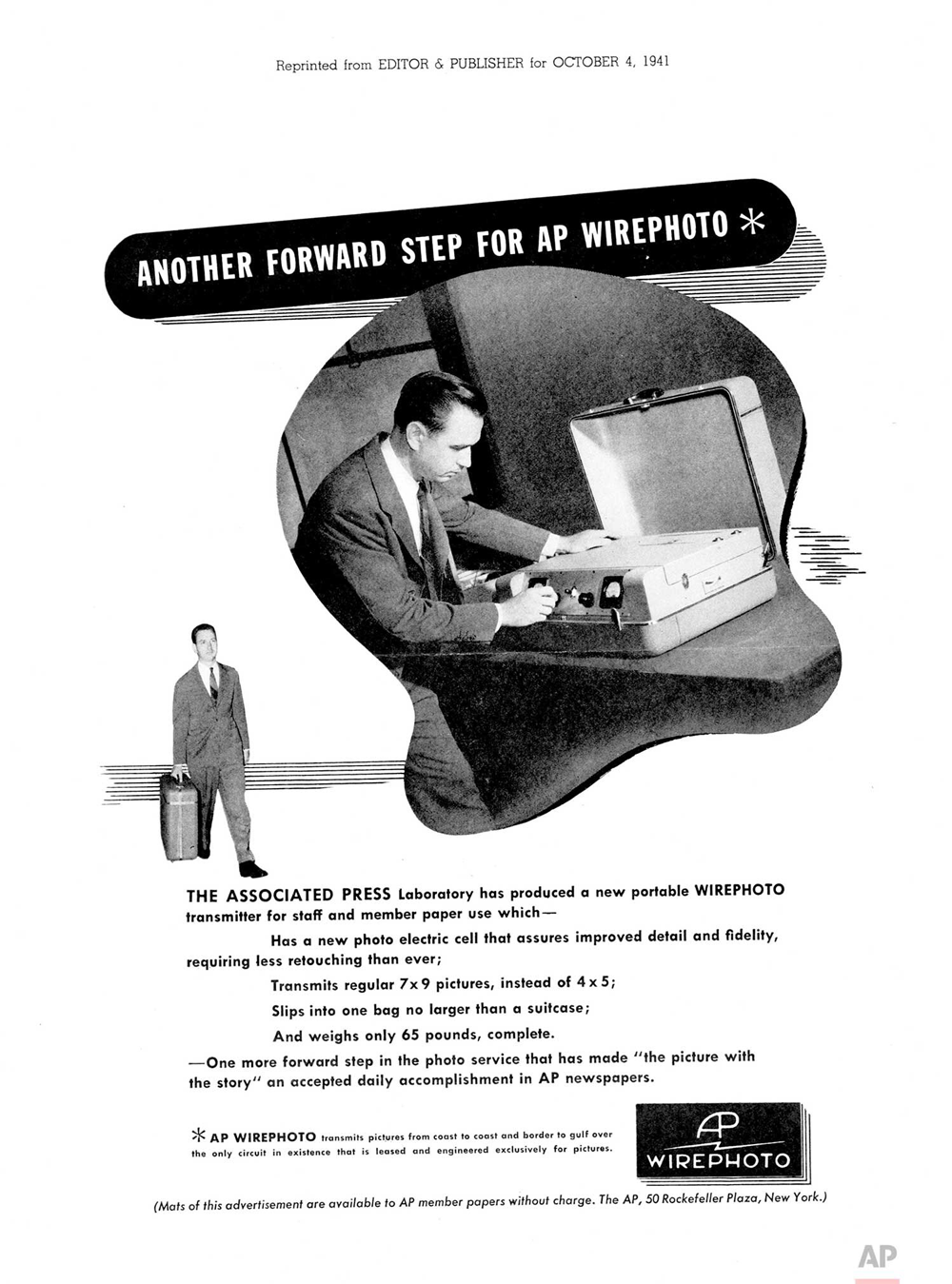
An early advertisement for a portable AP Wirephoto transmitter. (via the Associated Press Images blog)
Wirephoto was a major innovation, but one that the AP was willing to modernize over time. The AP developed a Wirephoto transmitter for photojournalists that could send pictures at normal photographer dimensions. (An ad for the transmitter, as featured on the AP Images blog, describes the device, shown fitting in a large-ish briefcase as “weighs only 65 pounds, complete.” Oh, those poor photographers’ arms.)
As imaging quality improved, AP worked to keep up with technological needs. In 1974, Popular Science reported on the AP’s decision to upgrade the Wirephoto machines to “Laserphotos,” an effort jointly developed with MIT that effectively sounds like a move to bring Xerography to the AP wire, as well as digital transmissions. The move was necessary in part because of the rising use of offset printing at the time, which could print at a higher quality that made imperfections in the older process more noticeable.
“The digital network, besides being faster, is virtually immune to telephone line noise that can mar picture quality,” the report noted. “The combination of laser and computer technology will put a new look in the news photos you see every day.”
(Little did that Popular Science reporter know how much that computers and lasers would come to improve things.)
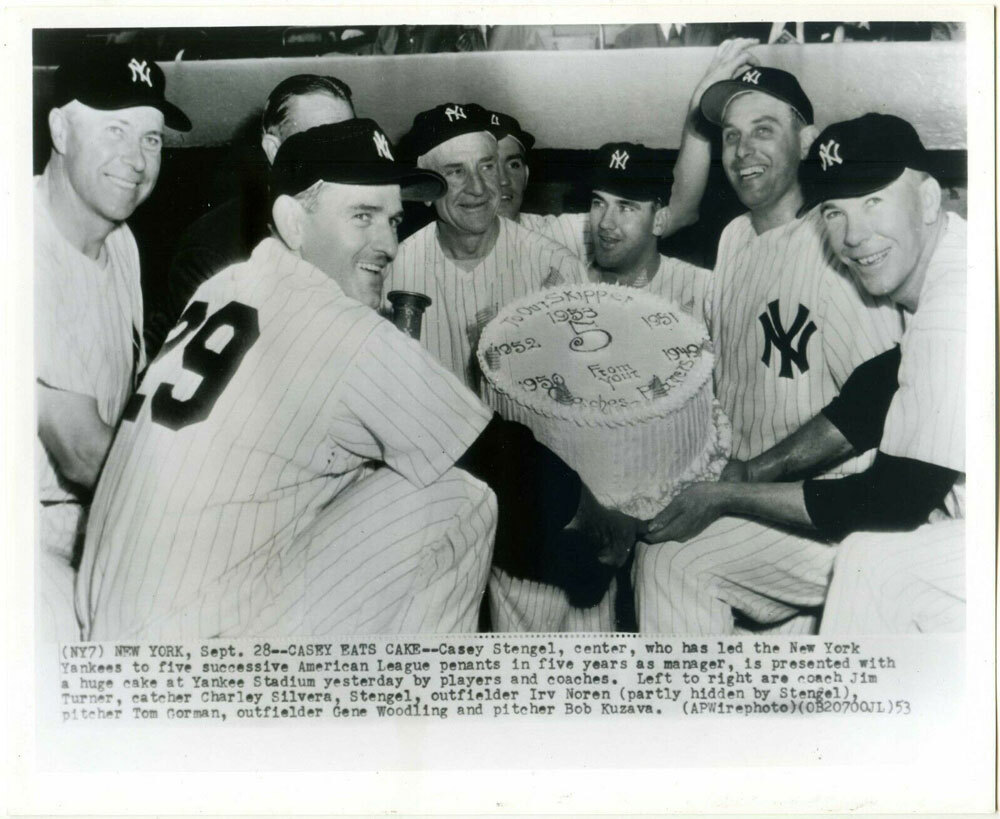
An example of a photo published on the AP wire circa the 1950s. (via eBay)
Technology also improved for reporters as well: By the early 1980s, the 65-pound portable transmitters had been replaced by the AP Portable Picture Transmitter, which included distribution methods over phone and radio, along with a microprocessor. It could also distribute color photographs, which had become common by this point (though, interestingly, not in The New York Times, The Washington Post, and The Wall Street Journal).
As PetaPixel reported last month, the transmission times that we take for granted today were still well above the 10-minute mark at this point, even with the improved technology.
UPI’s photo transmission time wasn’t much better during this period—taking nearly 10 minutes to send a black-and-white photo—and it was also loud.
By the early ’90s, desktop publishing conventions and electronic distribution innovations had started to simplify this process, which became simpler still as digital cameras began to take photos that meet or exceed the quality of a film print. By the time I started working at newspapers around 2004, the 65-pound “portable” suitcases had long become a thing of the past, which I’m sure must have been great for a lot of photojournalists … especially those photojournalists’ backs.
“The ultimate way to identify the wirephoto (the received image) is to look for the tiny horizontal or vertical lines in the image.”
— David Cycleback, a writer for Sports Collectors Daily, discussing the way that collectors can identify wire photos for sale, which often aren’t identified as wire photos on sites like eBay. Much as union labels are a great way to age a piece of clothing, the imperfections of wire photos help to make clear the source of an image.
Wire photos played an important role in the innovations we saw around image quality and photographic distribution in the 20th century, and not all of those innovations hit the same way everywhere.
There is an important wrinkle in the history of phototelegraphy that emerged in Japan in the 1920s, driven by a single news story, that gave that country its own distinct take on the rise of photographic distribution.
When Emperor Showa—also known as Hirohito, a pivotal and controversial figure in Japanese history—was brought to the throne in the late 1920s, newspapers throughout the region hoped to quickly report the news, complete with pictures. This largely meant the importation of mechanisms from around the world that could quickly move these photos as needed.
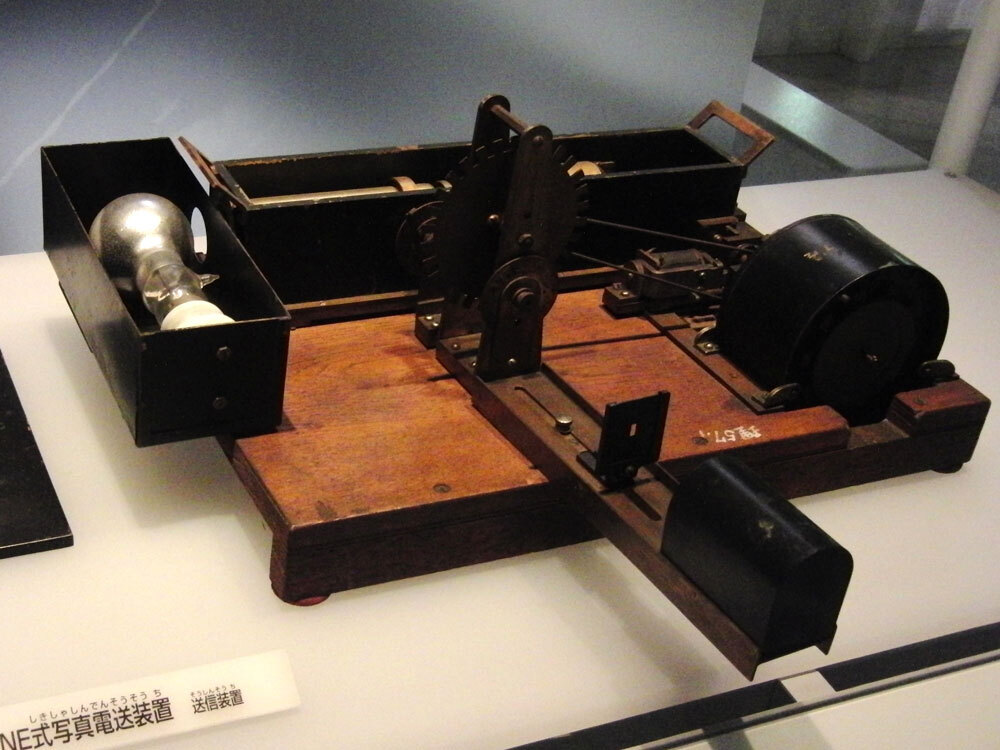
An example of the NE-type phototelegraphic system developed by NEC employees in the 1920s. (Momotarou2012/Wikimedia Commons)
But a homegrown effort ended up winning. Yasujiro Niwa and Masatsugu Kobayashi, scientist who worked for the Nippon Electric Company (known today as NEC—yes, the same one that developed the TurboGrafx-16), came up with their own system of transmitting an image over wires, and it ended up proving the most successful model, outpacing technologies brought in from abroad.
“Its development was a major technological feat for Japan, which was still a third-rate country in terms of technology,” an IEEE analysis of the invention states.
Japan would come to dominate the manufacture of electronics in later decades—and in many ways, this invention would be the first shot across the bow that highlighted this. As author Jonathan Coopersmith notes in the 2015 book Faxed, “The introduction of faxing exemplified the Japanese approach to modernization: gathering information about foreign activities; arranging demonstrations of foreign equipment; cooperating with foreign firms and engineers; and developing the expertise to create their own system.”
(It worked better than what AT&T was offering, though! All apologies to Herbert E. Ives.)
The interest in the fast distribution of high-quality news photos would in many ways prove the spark of innovation that not only drove later technologies like the fax machine and television, but arguably gave Japanese manufacturers the first shot of confidence on the global stage to eventually dominate the electronics industry. Not a bad feat.
--
Find this one an interesting read? Share it with a pal!
And thanks to our sponsor, Newspapers.com. It’s a favorite of ours, and if you look around, it might become a favorite of yours, too.





